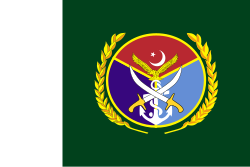Joint Staff Headquarters (Pakistan)
| Joint Staff Headquarters | |
|---|---|
| Coordinates | 33°35′45″N 73°05′24″E / 33.59593°N 73.09004°E |
| Year(s) built | 1972–77 |
| Opened | 1976 |
| Owner | Ministry of Defence (MoD) |
| Design and construction | |
| Engineer | Pakistan Army Corps of Engineers |
| Designations | JS HQ |
| Website | |
| JS HQ Website | |

The Joint Staff Headquarters (
Constructed on an accelerated schedule in 1972, the JS HQ, which also includes the post of Army GHQ, serves as a principle headquarters of the Pakistan Armed Forces with concerns relating to higher direction of war, operational planning, and deterrence developments.: 46 [1]
Historical background
From 1947–71, the Pakistan's
The War Enquiry Commission was very critical of the performance of the military from 1947–71, and stressed it on a singular command structure to provide combat synergy between nation's each armed service.: 145 [3] In 1976, the bureaucratic structure was modeled and build in an accelerated schedule by establishing the JS HQ, which was set up to improve coordination, command, and communication between the branches of the Pakistan Armed Forces.[4] In 1977, the JS HQ began to issue directives on mission parameters and requirements for development of nuclear weapon design to the nation's weapons laboratories.: 47 [1]: 331–332 [5]
In 1984—86, many of the Army GHQ's directorates, mainly the weapon system procurement, deployments, weapon selections, and overall mission preparedness and execution of the military operations, were transferred to the JS HQ in light of recommendations provided by the War Enquiry Commission (1975) and the Packard Commission (1985). : 48–50 [1] This directive strengthened the role of the JS HQ's command and control of the Pakistani military with chiefs of the staff of army, navy, and air force, still maintain their control of their respected services.: 49 [1]
Besides the nuclear command and control, the JS HQ provides the control, clarity, mission parameters, objectives, selection of weapon system to nation's armed services to execute the mission and attain objectives.: 48–49 [1]
Branches of the Joint Staff
The Director of the Joint Staff, an army officer holding a rank of
| Branches at the JS HQ |
| ||||||||||||||||||||||||||||||||||||||||||||||||||||||
(Source: More citations needed)
|
Organizations
- Inter-Services Intelligence
- Inter-Services Public Relations
- Inter-Services Selection Board
- Inter-Services Nursing Service
- National Defense University
- Pakistan Armed Forces Band
- Pakistan Armed Services Board
- Strategic Plans Division
- Global Industrial Defence Solutions[6]
Joint Staff Command in Media
-
General Peter Pace reviewing parade at the JS HQ.
-
A briefing sessions of Inter-Services personnel at JS HQ.
-
AdmiralMike Mullenreviewing parade at the JS HQ.
-
An outside view of JS HQ.
-
The military vehicle designed for the Chairman Joint Chiefs with four-star visibly marked.
See also
- Air Headquarters, Pakistan Air Force
- General Headquarters, Pakistan Army
- Naval Headquarters, Pakistan Navy
References
- ^ ISBN 978-0-230-51352-5. Retrieved 1 January 2024.
- ^ ISBN 978-0-8147-1633-5. Retrieved 3 January 2024.
- ISBN 978-0-230-59904-8. Retrieved 4 January 2024.
- ISBN 978-0801487040. Retrieved 11 May 2012.
- ISBN 978-0-8047-8480-1. Retrieved 4 January 2024.
- ^ "Country to be self-sufficient in making submarines soon: KS&EW official". 17 November 2022.





